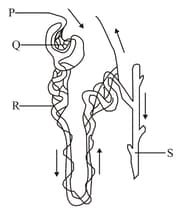NCERT Solutions for Chapter: Life Processes, Exercise 1: Exercise
NCERT Science Solutions for Exercise - NCERT Solutions for Chapter: Life Processes, Exercise 1: Exercise
Attempt the practice questions on Chapter 6: Life Processes, Exercise 1: Exercise with hints and solutions to strengthen your understanding. Science Textbook of Competency Based Questions for Class X solutions are prepared by Experienced Embibe Experts.
Questions from NCERT Solutions for Chapter: Life Processes, Exercise 1: Exercise with Hints & Solutions
Many processes happen in the bodies of living organisms.
Those processes which involve the building up of complex molecules from simple ones are called anabolism. Those which involved the breakdown of complex molecules into simple ones are called catabolism.
Which of the following life processes can be considered as an example of anabolism?
Given below is a diagram of a nephron.

Which of the following option correctly shows where filtration and selective reabsorption occur?
Which of the following option shows the correct products of anaerobic respiration in humans and in yeast?
Read the following two statements and answer the question.
Gatroparesis is a disease in which the muscles of the stomach become paralysed and cannot contract or relax.
Foods high in fat can delay the process of digestion and the emptying of the stomach.
Which of the following food would be advised to a patient suffering from Gastroparesis?
Which row of the table given below correctly gives the movement of gases across the blood and cells.

Read the following statements.
X: Amount of carbon dioxide produced per molecule of glucose during aerobic respiration.
Y: Amount of carbon dioxide produced per molecule of glucose during fermentation by yeast.
Which of the following is true about X and Y?
A major portion of the carbohydrates produced by plants is stored in different parts of the plant (storage organs). Explain the mechanism by which this stored food is made available when different organs need it for growth.
There are various muscles present in the human digestive system known as sphincters. Two examples of those are given below:
1. Pyloric sphincter- at the junction of the stomach and small intestine.
2. Anal sphincter- at the anus.
Give ONE most likely consequence of malfunctioning of each of these sphincters?
